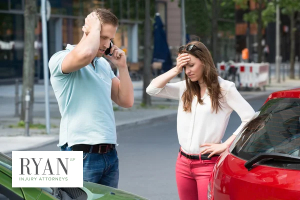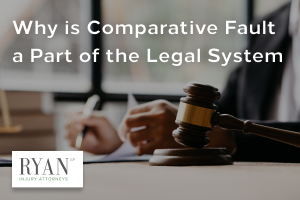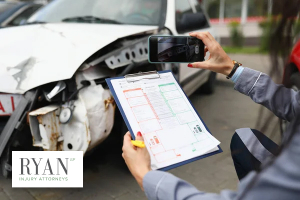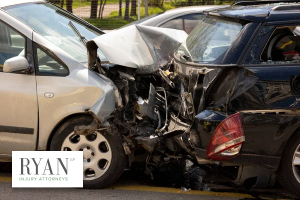
Car accidents can be complicated, especially when figuring out who is at fault. In many cases, more than one person might share the blame. This is where the concept of comparative fault comes in. It helps to decide how much each person involved in the accident has to pay.
Pure and modified comparative negligence can play a role in your personal injury case. At Ryan LLP, we are familiar with comparative negligence rules, including the modified comparative negligence rule. We have seen how pure comparative fault and modified comparative fault impact the outcome of personal injury cases. We can also explain how comparative negligence law might affect your case. Learn more about pure comparative negligence rules below. Then, contact us to schedule a free case consultation.
Comparative fault means sharing the blame in an accident. It's a way to determine how much each person involved in an accident is at fault. This concept is crucial because it affects how much money each person has to pay or receive. Each party involved could be assigned a portion of the blame.
Under comparative fault, you can still get some money, even if you are partly to blame for an accident. But the amount you receive depends on how much the accident was your fault. For example, if you are 30% at fault, you might only get 70% of the total damages. You need to understand how the pure comparative negligence system and the modified comparative negligence system might impact the outcome of your case.
Pure comparative negligence allows a damaged party to recover some damages regardless of their degree of fault, even if they are more at fault than the other party. In contrast, modified comparative negligence sets a threshold for guilt, typically at 50% or 51%. This is the system that Ohio uses.
Under this system, you cannot recover any damages if you are more at fault than this threshold. In pure comparative negligence, you can always recover some amount, but in modified comparative negligence, being too much at fault bars recovery.

Comparative fault is part of the legal system to make things fair. It helps ensure that each person pays only for their role in an accident. This way, one person doesn't have to pay for everything if it wasn't all their fault.
This system also encourages safer driving. Knowing that you could be partly responsible for an accident makes you more likely to be careful. Comparative fault is all about fairness and responsibility on the road. Reach out to us with any questions about the pure comparative negligence rule.
Several principles play a role in determining fault concerning the parties involved. A few regulations that could impact how you recover damages include:
In comparative fault, the first step is to decide how much each person is responsible for. Lawyers and judges look at what each person did to cause the accident. They use this information to figure out who is more at fault.
Once they decide the level of responsibility, they use it to calculate damages. The more you are at fault, the less money you can get. This allocation is a big part of how comparative fault works. Let our personal injury law firm represent you.
Deciding the percentage of fault is a detailed process. Lawyers look at everything that happened in the accident. They consider speed, traffic signals, and each driver's actions. Drunk driving could also have contributed to the crash.
The percentage of fault is significant because it directly affects the money involved. A higher percentage of fault means you'll likely pay more or receive less. This assessment is all about the details of the accident. Our personal injury law firm is here for you.
Comparative fault directly impacts the damages you can get. If you're partly at fault, your damages get reduced by your percentage of fault. This reduction is vital to how comparative fault affects car accident cases.
For example, if your damages total $100,000 but you're 40% at fault, you'd only get $60,000. This reduction makes sure that everyone pays their fair share. It's a significant aspect of comparative fault in car accidents.

Comparative fault is different from contributory negligence. In contributory negligence, you might not recover any money if you're even slightly at fault. This system is much stricter than comparative fault.
Only a few places use contributory negligence. Most sites use comparative fault to allocate damages. It lets people who are partly at fault still get some damages, but the award is reduced slightly.
Evidence is crucial in comparative fault cases. It helps prove who was at fault and by how much. Lawyers use evidence to build their cases and argue about the percentage of fault.
Common types of evidence include witness statements, traffic camera footage, and police reports. This evidence helps show what happened in the accident. It's the backbone of any comparative fault case, and we have a long track record of successful cases.

Economic damages are things like medical bills and lost wages. They're costs that you can calculate easily. In comparative fault cases, these damages get reduced based on your percentage of fault.
For instance, if your medical bills are $50,000 and you're 20% at fault, you'd get $40,000. This reduction reflects your part in the accident. Economic damages are an explicit part of the compensation in these cases.
Non-economic damages are things like pain and suffering. They're harder to put a number on but are still crucial in comparative fault cases.
These damages also get reduced by your percentage of fault. If you're 30% at fault, you'd get 70% of the non-economic damages. This reduction helps keep things fair in the case.
Punitive damages are different. They're about punishing the person who was more at fault. These damages only come up in some cases. Your percentage of guilt doesn't reduce punitive damages. They're meant to be a lesson to the person who caused the accident.
Understanding these misconceptions is critical to navigating comparative fault. Knowing the truth can significantly help you if you're ever in a car accident. Reach out to our team for legal guidance.

Multi-vehicle accidents are complicated. With more cars, figuring out faults gets harder. Comparative fault still applies, but it's more complex. Dividing up the responsibility among multiple parties is a major challenge, so be sure you know what to do after a car accident occurs.
In these cases, each driver's actions get looked at closely. The fault might get shared among several drivers, impacting the damages each person can recover.
The comparative fault affects insurance claims. It changes how much money you recover from your insurance. Insurance companies use comparative fault to decide how much to pay.
If you're partly at fault, your insurance payout might be reduced. Reach out to us for help maximizing the value of your insurance claim. We fight for injury victims.
The top benefits of having a lawyer who can help you with your auto accident case include:
Having the right lawyer can make a big difference in comparative fault cases. They guide you through the process and fight for your rights. Their expertise can be a big help in getting you a fair deal.

If you're in a car accident in Ohio, Ryan LLP is here to help. Our team understands the complexities of comparative fault. We'll work hard to get you the best outcome. At Ryan LLP, we focus on your needs. We'll guide you through every step of the process. Our goal is to make sure you get fair compensation for your accident.
Don't let the stress of a car accident overwhelm you. Contact us today. We're ready to fight for you and protect your rights.